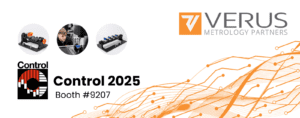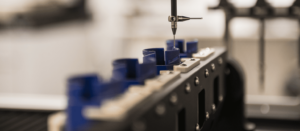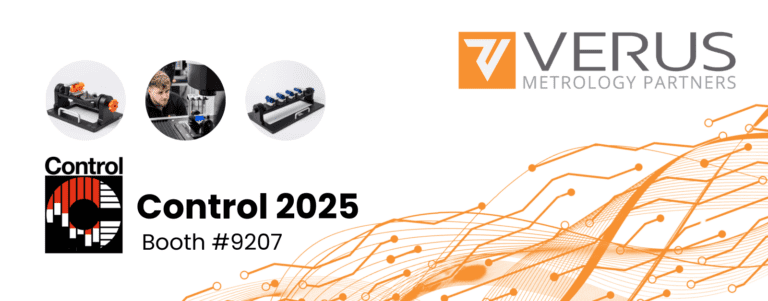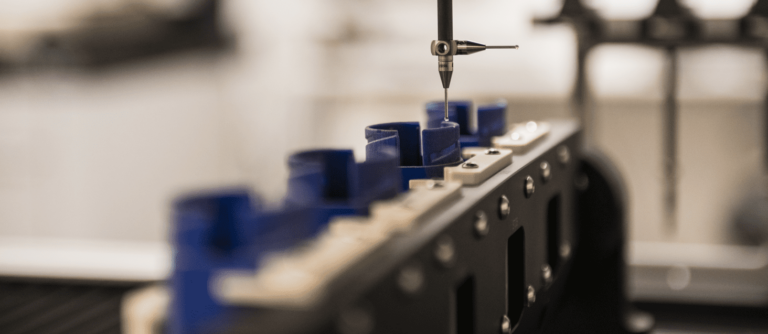Mastering Complexity: Dimensional Inspection of Intricate Components
As products become more sophisticated and miniaturised, especially within the MedTech sector, the demand for precise and repeatable dimensional inspection of complex parts is growing rapidly. Components such as implantable devices, catheter hubs, microfluidic cartridges, and surgical tool parts are often characterised by intricate geometries, ultra-small features, and tight dimensional tolerances. These are not just manufacturing feats—they are metrology challenges.
Unlike standard components, these intricate parts require an elevated level of inspection capability. The risk of dimensional inaccuracy—whether due to part deformation, fixturing instability, or inadequate measurement processes—can have serious downstream consequences. In regulated industries, those consequences include compliance breaches, compromised patient safety, production delays, and increased waste or recalls.
Dimensional inspection is no longer a “step” in the quality process—it is integral to product validation, regulatory compliance, and ongoing process improvement. However, inspecting complex parts with confidence requires more than just advanced equipment. It demands a structured, validated, and tailored approach—one that considers everything from fixturing and measurement routines to environmental control and Gage R&R validation.
1. Why Complex Parts Are So Difficult to Measure
The dimensional inspection of complex parts presents a unique set of challenges that go far beyond what traditional measurement processes are designed to handle. These challenges are especially prevalent in the medical device industry, where precision, repeatability, and traceability are essential for both product performance and regulatory compliance.
1.1 Ultra-Small Features and Tight Tolerances
Many MedTech components include features that are just fractions of a millimetre in size—internal channels, undercuts, thin walls, microgrooves, or complex contours that require sub-micron accuracy. These features can be beyond the capability of standard tactile probes or visual systems to detect and measure reliably without distortion or error. The smaller the feature, the more critical even the slightest deviation becomes.
Tolerances in the medical device industry often range within a few microns, with typical specs such as ±5 µm or tighter. This leaves little room for error—not only in the manufacturing process but also in the inspection routine. If your inspection process cannot repeatedly verify dimensional conformity within these tolerances, the data it generates is effectively unreliable.
1.2 Complex Geometries and Accessibility
Components with complex geometries—internal cavities, 3D surfaces, multi-axis profiles—often cannot be measured effectively using a single sensor type or approach. These parts
may require a combination of tactile probing and non-contact vision systems to access all critical features. In some cases, features may not be visible at all using standard inspection angles, necessitating creative fixture design or multi-sensor strategies.
Moreover, the positioning of a complex part is just as critical as its measurement. Any misalignment, vibration, or instability during inspection can introduce measurement error or variance, especially when features are difficult to reach or inspect consistently.
1.3 Material Behaviour and Surface Sensitivity
Many intricate components in MedTech are made from soft or semi-flexible materials like polymers, silicones, or hybrid composites. These materials can deform under the pressure of a tactile probe or due to environmental factors such as temperature or humidity. They may also have reflective or translucent surfaces that present challenges for optical systems.
This introduces two key risks:
· False confidence in measurements that appear stable but are influenced by probe pressure or lighting.
· Missed features or inaccurate data due to material behaviour during inspection.
A metrology solution must be tailored not only to the shape and size of the component, but also to its material properties.
1.4 Operator Influence and Repeatability
Even with advanced equipment, operator intervention introduces risk. The way a part is placed on a fixture, how a measurement routine is executed, or how results are interpreted can all impact repeatability. For ultra-small or intricate parts, even minor handling inconsistencies can lead to large measurement errors relative to the tolerance window.
This highlights the importance of automation, reliable fixturing, and routine validation processes like Gage R&R to minimise operator influence and maintain consistency across inspection cycles.
2. The Risk of Inadequate Dimensional Inspection
In industries where the margin for error is virtually nonexistent—like MedTech, pharmaceutical, and aerospace manufacturing—the stakes of getting dimensional inspection wrong are exceptionally high. It’s not just about ensuring parts are within spec; it’s about ensuring the data you’re relying on is trustworthy, validated, and repeatable.
2.1 Misleading Data = Faulty Decisions
When a measurement system lacks precision or consistency, it produces data that may appear to validate a part, even though it’s outside of acceptable tolerances—or worse, may reject parts that are perfectly within spec. In both cases, the risk to the business is significant:
· False negatives can lead to regulatory non-compliance or field failures.
· False positives contribute to unnecessary scrap, rework, and production delays.
· Inconsistent data undermines confidence in quality systems, making root-cause analysis more difficult and time-consuming.
In the MedTech sector, these issues don’t just affect manufacturing efficiency—they can compromise patient safety and regulatory approval.
2.2 Non-Compliance with Regulatory Standards
Regulatory bodies such as the FDA, ISO, and European MDR demand rigorous evidence that medical devices are manufactured within validated, controlled processes. Dimensional inspection data plays a critical role in this validation—especially during:
· First Article Inspection (FAI)
· Process verification and validation
· Ongoing production monitoring
· Design and process change control
If a manufacturer’s measurement system cannot produce verified and repeatable results, it becomes a compliance liability. This can result in:
· Audit findings or regulatory warnings
· Delayed product launches
· Increased cost of validation
· Product recalls or post-market corrective actions
2.3 Cost of Inaccuracy
While the cost of a failed inspection or non-conformance is easy to quantify in terms of scrap or downtime, the true cost of inaccuracy is often hidden. These costs might include:
· Increased validation cycles due to questionable measurement results
· Inefficient production processes caused by over-inspection or underconfidence in data
· Staff time lost troubleshooting inspection issues instead of optimising throughput
· Missed opportunities to streamline manufacturing because data can’t be trusted
Dimensional inspection should not be viewed solely as a regulatory hurdle—it is a business enabler. When done properly, it unlocks efficiencies, reduces risk, and provides confidence in every production decision.
3. Solutions: Proven Approaches to Metrology for Complex Parts
Effective dimensional inspection of complex parts—especially in critical industries like MedTech—requires more than access to advanced equipment. It demands a systematic, validated, and tailored approach that considers not just what you’re measuring, but how, where, and with what level of confidence. Below, we explore four core pillars that consistently deliver reliable and reproducible inspection results.
3.1 Fixturing for Stability and Repeatability
Custom metrology fixtures are foundational when inspecting parts with intricate geometries, fragile features, or challenging tolerances. Without a secure and repeatable setup, even the most sophisticated metrology equipment can produce unreliable results.
At Verus, metrology fixturing is engineered with precision for:
· Component stability: The fixture must hold the part securely in place, often in complex orientations, without distorting flexible materials like medical-grade polymers.
· Minimised operator influence: Designed for ease of use, the fixture should reduce setup variability by enabling straightforward, repeatable loading.
· Efficient measurement access: Fixtures often incorporate features like rotational capability or multiple stations to provide unobstructed access to critical features in a single inspection routine.
· Compatibility with inspection equipment: Fixtures are tailored to match the machine’s probing or vision field, whether for CMMs, optical comparators, or non-contact systems.
By enabling consistent orientation, part stability, and controlled probing access, custom fixturing eliminates a primary source of measurement variation: human error.
3.2 Inspection Programming and Software Optimisation
Dimensional inspection is only as effective as the measurement routine behind it. Complex parts often require sophisticated programming strategies to ensure coverage, avoid collisions, and account for unique part characteristics.
Key programming approaches include:
· CAD-based offline programming: This allows engineers to build and simulate the inspection routine before it’s deployed, which is particularly useful when parts are difficult to access or when programming must be completed before production begins.
· Multisensor strategies: Using tactile probes, vision systems, or laser scanners in combination allows for measurement of diverse feature types—e.g., micro-holes with vision, deep cavities with tactile probing.
· Defined approach paths: For features in restricted or hidden areas, the path the probe takes must be tightly controlled to avoid unintended contact or misalignment.
· Optimisation for speed and safety: A well-structured routine reduces inspection time while ensuring safe, non-invasive interaction with delicate features.
Incorporating inspection programming into the overall metrology plan ensures that the system is delivering accurate data while also operating efficiently in a production environment.
3.3 Environmental Control in the Metrology Lab
Inspection accuracy is significantly influenced by the environment in which it takes place—especially for parts with tight tolerances or flexible materials. Even minor changes in temperature or vibration levels can introduce measurement error.
To control for these variables, advanced metrology labs are equipped with:
· Strict temperature control (often regulated at 20°C ± 1°C), ensuring parts and probes remain dimensionally stable.
· Humidity and vibration monitoring, critical when inspecting sensitive polymer or elastomer components.
· Isolated and sealed inspection zones, minimising airborne contaminants and maintaining cleanliness suitable for medical device components.
· Regular calibration and equipment maintenance, aligned with ISO 17025 standards for traceability and measurement uncertainty.
Verus’ labs, for example, are monitored 24/7 and equipped to closely replicate client conditions. This ensures that inspections are not only accurate but also directly transferable to the customer’s production environment.
3.4 Gage R&R: Verifying Measurement System Reliability
Even with the right equipment, fixturing, and routine, measurement system validation is essential. That’s where Gage Repeatability and Reproducibility (Gage R&R) studies come into play.
Gage R&R quantifies how much of the total measurement variation is due to the inspection system itself. Specifically, it answers two questions:
· Repeatability: Can the same operator, using the same equipment, measure the same part multiple times with consistent results?
· Reproducibility: Can different operators achieve the same results under the same conditions?
Gage R&R provides manufacturers with clear, data-driven confidence in their inspection process. It is particularly vital for:
· New product introductions (NPIs)
· Validating custom fixtures
· Troubleshooting quality deviations
· Supporting regulatory documentation for audits
At Verus, every metrology fixture undergoes a Gage R&R study before being shipped. This ensures that when it reaches the client, the system is validated and ready to produce repeatable, reproducible, and reliable results.
4. Best Practices Going Forward
For manufacturers working with intricate components, especially in high-regulation sectors like MedTech, dimensional inspection should not be treated as a standalone step. It must be woven into the broader quality and production strategy. Below are best practices drawn from real-world experience that help teams consistently deliver precise, reliable, and compliant measurement outcomes.
4.1 Design for Inspection from the Outset
Inspection should be considered early in the product development cycle—not after the fact. This design-for-inspection (DFI) mindset helps avoid features that are inherently difficult or impossible to measure reliably, while also ensuring that inspection processes align with product function.
Key actions include:
· Collaborating between design, manufacturing, and metrology teams early in the project lifecycle.
· Identifying critical-to-quality (CTQ) dimensions that require heightened focus.
· Assessing whether proposed geometries can be effectively measured using existing equipment and inspection strategies.
When inspection is considered upfront, fixture development, programming, and process validation become smoother, faster, and more accurate.
4.2 Use Measurement Data as a Strategic Tool
Dimensional inspection data should be more than a pass/fail gate—it should drive decision-making. With the right setup, manufacturers can extract insights from inspection data to:
· Identify early trends in process variation.
· Support continuous improvement initiatives.
· Optimise manufacturing tolerances without sacrificing compliance.
· Minimise over-engineering, which can increase costs without meaningful benefit.
This shift from reactive to data-informed quality control empowers engineering teams to enhance efficiency and scalability while maintaining strict compliance standards.
4.3 Prioritise Operator Training and Knowledge Retention
Even the most advanced inspection systems can underperform if operated incorrectly. Ensuring that the personnel responsible for dimensional inspection understand the fundamentals of metrology—as well as the specifics of the system in use—is key.
Effective strategies include:
· Implementing structured metrology training programs with OEM certification where applicable.
· Providing cross-training across fixture use, programming, and machine maintenance.
· Using visual aids and standard operating procedures (SOPs) to reduce setup errors and ensure consistency.
· Documenting and regularly reviewing measurement processes for continuous improvement.
At Verus, for example, all engineers are trained through an in-house development program supported by statistical process control (SPC), GD&T, and OEM-specific systems. This approach enables consistency across global teams and ensures data integrity.
4.4 Validate Inspection Systems Regularly
Metrology systems must remain calibrated and validated over time, particularly when new products are introduced or when measurement anomalies occur. Regular review of system performance ensures ongoing compliance and reduces the risk of undetected drift.
Essential validation actions include:
· Routine Gage R&R studies for high-risk or high-volume components.
· Periodic equipment calibration traceable to ISO 17025 or equivalent standards.
· Verification of fixturing performance—particularly when dealing with multi-station or rotational setups.
· Incorporating verification procedures into production planning for new tooling, product launches, or process changes.
By embedding validation into the inspection lifecycle, organisations can maintain consistent quality while minimising revalidation delays and audit risks.
Precision Requires Planning
The dimensional inspection of complex parts—especially those found in critical applications like medical devices—is one of the most demanding aspects of modern manufacturing. These components test the limits of measurement systems, from probe and sensor capabilities to fixturing stability and operator influence.
The good news is that with a methodical, evidence-based approach, these challenges are entirely solvable. By integrating high-precision fixturing, intelligent inspection programming, controlled environments, and Gage R&R validation, manufacturers can gain absolute confidence in their metrology process. And more importantly, they can deliver products that meet both internal quality standards and stringent regulatory expectations.
The key takeaway: inspection is not a checkpoint—it’s a capability. When it’s built into the design, planning, and validation phases, dimensional inspection becomes a powerful enabler of innovation, compliance, and competitive advantage.
If you’re looking to strengthen your dimensional inspection capabilities—whether through better fixturing, validated routines, or lab-based measurement support—it’s worth partnering with experts who understand both the technical and regulatory demands of your industry.
📍 Visit our Dimensional Metrology & Inspection Services page to explore how we approach complex part inspection for the world’s leading MedTech manufacturers.
Let’s ensure your measurement process is as robust as the parts you’re producing.







